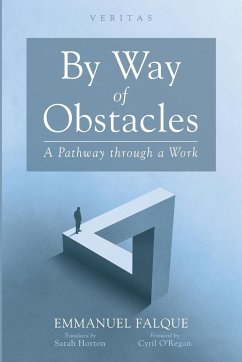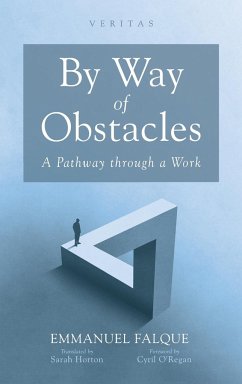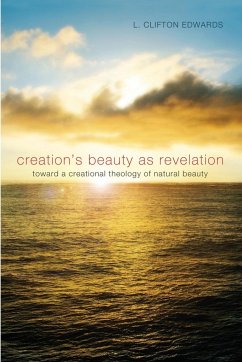Rolfe King
Obstacles to Divine Revelation
Rolfe King
Obstacles to Divine Revelation
- Gebundenes Buch
- Merkliste
- Auf die Merkliste
- Bewerten Bewerten
- Teilen
- Produkt teilen
- Produkterinnerung
- Produkterinnerung
A fascinating, philosophical approach to the concept of divine revelation, exploring the implications this theory may have for generating a new concept of religious truth.
Andere Kunden interessierten sich auch für
![The Philosophy of Revelation The Philosophy of Revelation]() Herman BavinckThe Philosophy of Revelation27,99 €
Herman BavinckThe Philosophy of Revelation27,99 €![By Way of Obstacles By Way of Obstacles]() Emmanuel FalqueBy Way of Obstacles21,99 €
Emmanuel FalqueBy Way of Obstacles21,99 €![By Way of Obstacles By Way of Obstacles]() Emmanuel FalqueBy Way of Obstacles33,99 €
Emmanuel FalqueBy Way of Obstacles33,99 €![Creation's Beauty as Revelation Creation's Beauty as Revelation]() L. Clifton EdwardsCreation's Beauty as Revelation23,99 €
L. Clifton EdwardsCreation's Beauty as Revelation23,99 €![Revelation of Truth Revelation of Truth]() Clinton BezanRevelation of Truth19,99 €
Clinton BezanRevelation of Truth19,99 €![On the Perpetual Strangeness of the Bible On the Perpetual Strangeness of the Bible]() Michael EdwardsOn the Perpetual Strangeness of the Bible77,99 €
Michael EdwardsOn the Perpetual Strangeness of the Bible77,99 €![Theology's Epistemological Dilemma Theology's Epistemological Dilemma]() Kevin DillerTheology's Epistemological Dilemma38,99 €
Kevin DillerTheology's Epistemological Dilemma38,99 €-
-
-
A fascinating, philosophical approach to the concept of divine revelation, exploring the implications this theory may have for generating a new concept of religious truth.
Produktdetails
- Produktdetails
- Verlag: Bloomsbury 3PL
- Seitenzahl: 292
- Erscheinungstermin: 22. Januar 2009
- Englisch
- Abmessung: 240mm x 161mm x 20mm
- Gewicht: 605g
- ISBN-13: 9781847062581
- ISBN-10: 184706258X
- Artikelnr.: 24373306
- Herstellerkennzeichnung
- Libri GmbH
- Europaallee 1
- 36244 Bad Hersfeld
- gpsr@libri.de
- Verlag: Bloomsbury 3PL
- Seitenzahl: 292
- Erscheinungstermin: 22. Januar 2009
- Englisch
- Abmessung: 240mm x 161mm x 20mm
- Gewicht: 605g
- ISBN-13: 9781847062581
- ISBN-10: 184706258X
- Artikelnr.: 24373306
- Herstellerkennzeichnung
- Libri GmbH
- Europaallee 1
- 36244 Bad Hersfeld
- gpsr@libri.de
Rolfe King
Chapter 1: Initial Reflections
1.1 Introduction
1.2 Identifying our topic
1.3 Comments on method
1.4 Some key assumptions
1.5 Adjusting the focus
1.6 Some illustrations
Chapter 2: The God of History?
2.1 Recording history
2.2 Revelation as history
2.3 Hermeneutics
2.4 Some general features of obstacles to revelation
Chapter 3: Starting the Process
3.1 The Eden parable
3.2 Revelation and necessity
3.3 Analysing God's options
3.4 God's limited options
3.5 Evidence and the best plan
3.6 Some possible criticisms
Chapter 4: Evidence and Direct Cognition of God
4.1 Some background
4.2 Internalism v. externamlism
4.3 Models of direct knowledge of the truth of testimony
4.4 Evaluation of the models
Chapter 5: Knowledge and the Perception of God
5.1 Can God be perceived?
5.2 Language games and the name of God
5.3 Seeing the essence of God
5.4 Seeing the glory of God
Chapter 6: Knowledge and Obstacles to Direct Cognition
6.1 Direct cognition: a summary
6.2 Plantinga and the maximum pace of revelation
6.3 Obstacles to direct cognition
6.4 Coherence rationality and union with God
6.5 A Theory of Knowledge
6.6 The Eden parable revisited
Chapter 7: Major and Discreet Revelation
7.1 Great evidence
7.2 The "Gal" thought-experiment
7.3 Results and application
7.4 Obstacles to major revelation
7.5 Discreet revelation: the best strategy?
Chapter 8: Eschatological Revelation
8.1 The parable of the Throne and the Seed
8.2 Judgment and revelation
8.3 Judgement and the vision of God
8.4 The general problem of special revelation
Chapter 9: Divine Hiddenness
9.1 A third factor
9.2 The choice to hide
9.3 Obstacles or hiding?
9.4 Apophatic theology
Chapter 10: The Necessary Structure of Revelation
10.1 The story so far
10.2 God's limited opinions: types of divine self-testimony
10.3 Evidence, divine plans and the "Version B Model"
10.4 Features of the necessary structure
10.5 Approaching assurance
10.6 Miracles and necessity
10.7 Does Kant make any difference?
Chapter 11: Divine Self-testimony and the Journey to God
11.1 God and the contemporary debate over testimony
11.2 Journey-epistemology
11.3 Two kinds of rationality
11.4 Traditions and the awakening of the human ideal
11.5 The knowledge of God: head and heart
Chapter 12: The Journey of Faith
12.1 Confident faith?
12.2 Choosing to trust?
12.3 The moral ideal and the journey towards God
12.4 Faith and reason
Chapter 13: Providence and Revelation
13.1 The problem of evil
13.2 Modest theodicy
13.3 Providence and free will
13.4 Modeling omnipotence
Conclusion
References
Index
1.1 Introduction
1.2 Identifying our topic
1.3 Comments on method
1.4 Some key assumptions
1.5 Adjusting the focus
1.6 Some illustrations
Chapter 2: The God of History?
2.1 Recording history
2.2 Revelation as history
2.3 Hermeneutics
2.4 Some general features of obstacles to revelation
Chapter 3: Starting the Process
3.1 The Eden parable
3.2 Revelation and necessity
3.3 Analysing God's options
3.4 God's limited options
3.5 Evidence and the best plan
3.6 Some possible criticisms
Chapter 4: Evidence and Direct Cognition of God
4.1 Some background
4.2 Internalism v. externamlism
4.3 Models of direct knowledge of the truth of testimony
4.4 Evaluation of the models
Chapter 5: Knowledge and the Perception of God
5.1 Can God be perceived?
5.2 Language games and the name of God
5.3 Seeing the essence of God
5.4 Seeing the glory of God
Chapter 6: Knowledge and Obstacles to Direct Cognition
6.1 Direct cognition: a summary
6.2 Plantinga and the maximum pace of revelation
6.3 Obstacles to direct cognition
6.4 Coherence rationality and union with God
6.5 A Theory of Knowledge
6.6 The Eden parable revisited
Chapter 7: Major and Discreet Revelation
7.1 Great evidence
7.2 The "Gal" thought-experiment
7.3 Results and application
7.4 Obstacles to major revelation
7.5 Discreet revelation: the best strategy?
Chapter 8: Eschatological Revelation
8.1 The parable of the Throne and the Seed
8.2 Judgment and revelation
8.3 Judgement and the vision of God
8.4 The general problem of special revelation
Chapter 9: Divine Hiddenness
9.1 A third factor
9.2 The choice to hide
9.3 Obstacles or hiding?
9.4 Apophatic theology
Chapter 10: The Necessary Structure of Revelation
10.1 The story so far
10.2 God's limited opinions: types of divine self-testimony
10.3 Evidence, divine plans and the "Version B Model"
10.4 Features of the necessary structure
10.5 Approaching assurance
10.6 Miracles and necessity
10.7 Does Kant make any difference?
Chapter 11: Divine Self-testimony and the Journey to God
11.1 God and the contemporary debate over testimony
11.2 Journey-epistemology
11.3 Two kinds of rationality
11.4 Traditions and the awakening of the human ideal
11.5 The knowledge of God: head and heart
Chapter 12: The Journey of Faith
12.1 Confident faith?
12.2 Choosing to trust?
12.3 The moral ideal and the journey towards God
12.4 Faith and reason
Chapter 13: Providence and Revelation
13.1 The problem of evil
13.2 Modest theodicy
13.3 Providence and free will
13.4 Modeling omnipotence
Conclusion
References
Index
Chapter 1: Initial Reflections
1.1 Introduction
1.2 Identifying our topic
1.3 Comments on method
1.4 Some key assumptions
1.5 Adjusting the focus
1.6 Some illustrations
Chapter 2: The God of History?
2.1 Recording history
2.2 Revelation as history
2.3 Hermeneutics
2.4 Some general features of obstacles to revelation
Chapter 3: Starting the Process
3.1 The Eden parable
3.2 Revelation and necessity
3.3 Analysing God's options
3.4 God's limited options
3.5 Evidence and the best plan
3.6 Some possible criticisms
Chapter 4: Evidence and Direct Cognition of God
4.1 Some background
4.2 Internalism v. externamlism
4.3 Models of direct knowledge of the truth of testimony
4.4 Evaluation of the models
Chapter 5: Knowledge and the Perception of God
5.1 Can God be perceived?
5.2 Language games and the name of God
5.3 Seeing the essence of God
5.4 Seeing the glory of God
Chapter 6: Knowledge and Obstacles to Direct Cognition
6.1 Direct cognition: a summary
6.2 Plantinga and the maximum pace of revelation
6.3 Obstacles to direct cognition
6.4 Coherence rationality and union with God
6.5 A Theory of Knowledge
6.6 The Eden parable revisited
Chapter 7: Major and Discreet Revelation
7.1 Great evidence
7.2 The "Gal" thought-experiment
7.3 Results and application
7.4 Obstacles to major revelation
7.5 Discreet revelation: the best strategy?
Chapter 8: Eschatological Revelation
8.1 The parable of the Throne and the Seed
8.2 Judgment and revelation
8.3 Judgement and the vision of God
8.4 The general problem of special revelation
Chapter 9: Divine Hiddenness
9.1 A third factor
9.2 The choice to hide
9.3 Obstacles or hiding?
9.4 Apophatic theology
Chapter 10: The Necessary Structure of Revelation
10.1 The story so far
10.2 God's limited opinions: types of divine self-testimony
10.3 Evidence, divine plans and the "Version B Model"
10.4 Features of the necessary structure
10.5 Approaching assurance
10.6 Miracles and necessity
10.7 Does Kant make any difference?
Chapter 11: Divine Self-testimony and the Journey to God
11.1 God and the contemporary debate over testimony
11.2 Journey-epistemology
11.3 Two kinds of rationality
11.4 Traditions and the awakening of the human ideal
11.5 The knowledge of God: head and heart
Chapter 12: The Journey of Faith
12.1 Confident faith?
12.2 Choosing to trust?
12.3 The moral ideal and the journey towards God
12.4 Faith and reason
Chapter 13: Providence and Revelation
13.1 The problem of evil
13.2 Modest theodicy
13.3 Providence and free will
13.4 Modeling omnipotence
Conclusion
References
Index
1.1 Introduction
1.2 Identifying our topic
1.3 Comments on method
1.4 Some key assumptions
1.5 Adjusting the focus
1.6 Some illustrations
Chapter 2: The God of History?
2.1 Recording history
2.2 Revelation as history
2.3 Hermeneutics
2.4 Some general features of obstacles to revelation
Chapter 3: Starting the Process
3.1 The Eden parable
3.2 Revelation and necessity
3.3 Analysing God's options
3.4 God's limited options
3.5 Evidence and the best plan
3.6 Some possible criticisms
Chapter 4: Evidence and Direct Cognition of God
4.1 Some background
4.2 Internalism v. externamlism
4.3 Models of direct knowledge of the truth of testimony
4.4 Evaluation of the models
Chapter 5: Knowledge and the Perception of God
5.1 Can God be perceived?
5.2 Language games and the name of God
5.3 Seeing the essence of God
5.4 Seeing the glory of God
Chapter 6: Knowledge and Obstacles to Direct Cognition
6.1 Direct cognition: a summary
6.2 Plantinga and the maximum pace of revelation
6.3 Obstacles to direct cognition
6.4 Coherence rationality and union with God
6.5 A Theory of Knowledge
6.6 The Eden parable revisited
Chapter 7: Major and Discreet Revelation
7.1 Great evidence
7.2 The "Gal" thought-experiment
7.3 Results and application
7.4 Obstacles to major revelation
7.5 Discreet revelation: the best strategy?
Chapter 8: Eschatological Revelation
8.1 The parable of the Throne and the Seed
8.2 Judgment and revelation
8.3 Judgement and the vision of God
8.4 The general problem of special revelation
Chapter 9: Divine Hiddenness
9.1 A third factor
9.2 The choice to hide
9.3 Obstacles or hiding?
9.4 Apophatic theology
Chapter 10: The Necessary Structure of Revelation
10.1 The story so far
10.2 God's limited opinions: types of divine self-testimony
10.3 Evidence, divine plans and the "Version B Model"
10.4 Features of the necessary structure
10.5 Approaching assurance
10.6 Miracles and necessity
10.7 Does Kant make any difference?
Chapter 11: Divine Self-testimony and the Journey to God
11.1 God and the contemporary debate over testimony
11.2 Journey-epistemology
11.3 Two kinds of rationality
11.4 Traditions and the awakening of the human ideal
11.5 The knowledge of God: head and heart
Chapter 12: The Journey of Faith
12.1 Confident faith?
12.2 Choosing to trust?
12.3 The moral ideal and the journey towards God
12.4 Faith and reason
Chapter 13: Providence and Revelation
13.1 The problem of evil
13.2 Modest theodicy
13.3 Providence and free will
13.4 Modeling omnipotence
Conclusion
References
Index








